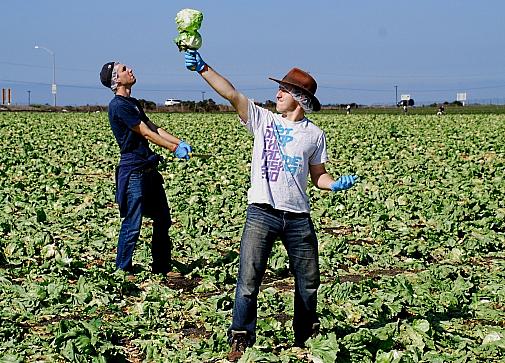Gleaning the fields: Volunteers gather fresh food for the poor
In this series, Maura Gaura and Tara Leonard focus on Santa Cruz efforts to transform food aid programs for the less fortunate. In this story, Gaura discusses food banking's new focus on distributing fruits and vegetables to the poor.
Part 1: Santa Cruz food bank switches focus from calories to nutrition
Part 2: The power of peer education: Nutrition education outreach at second harvest food bank
Part 3: Evaluating nutrition education efforts at Santa Cruz's Second Harvest Food Bank
Part 4: Santa Cruz farmers keep food banks afloat with tons of fresh produce
Part 5: Gleaning the fields: Volunteers gather fresh food for the poor

Gleaning the fields: Volunteers gather fresh food for the poor
CASTROVILLE, MONTEREY COUNTY, CA. - When harvesting Iceberg lettuce, first give the plump round head a squeeze. If the lettuce feels firm and dense, jab the wedge-shaped harvesting knife at the base of the plant to sever the stem, pull off the floppy outer leaves, and drop the moist green orb gently into the harvesting crate.
But if the lettuce gives beneath your touch, or has a spot of mold or a brown leaf, leave it behind. There are thousands of leftover lettuces in this ocean-view field, and our crew of volunteer gleaners has only one truck to haul away its share, so we take only the perfectly full and heavy Icebergs, and leave the rest for the plow.
It seems unbelievable that so many beautiful, perfectly-shaped vegetables will be tilled back into the earth, but in fact, an estimated 20 percent of all field crops grown on California’s Central Coast are left in the field or thrown out at the packing shed.
My fellow gleaners and I have gathered at 9 a.m. on a beautiful September Saturday to salvage lettuces for Ag Against Hunger, a farmer-run non-profit, and the salad greens we harvest will be boxed up and distributed to food banks throughout the Western U.S.
Ag Against Hunger volunteers meet weekly throughout the harvest season to collect whatever is available: apples, broccoli, peppers, cauliflower. Volunteers put on hairnets and blue plastic gloves, and receive a quick lesson in harvest technique. Many of the volunteers are young people from church groups, or students earning community service hours.
Gleaning is not a particularly serious or back-breaking business. “If you’re not having fun, you need to turn in your hair net and go home,” said glean manager Jim Geiger. “We’re here to have a good time.”
We’ve committed to a three-hour shift, but the lettuce harvest goes quickly, and our truck is loaded to the brim after about 90 minutes of work. Everybody takes one or two heads of lettuce to eat at home, or to share with neighbors. We’ve taken only the most perfect of the leftover lettuces from a small corner of the field, the rest will be turned under soon, and the planting cycle started anew.

